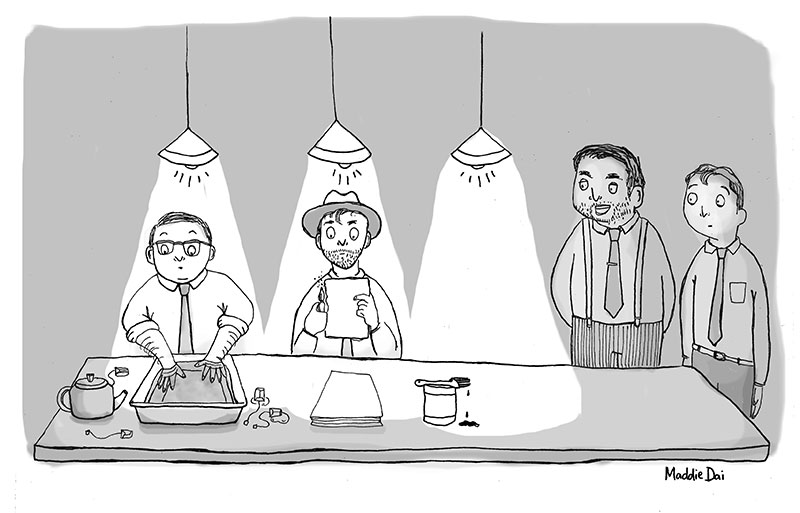 This contest is so challenging, Bob Mankoff received an e-mail from a former editor at The Wall Street Journal asking for help deciphering Maddie Dai’s cartoon. Bob didn’t give him or me any hints, but it looks like a counterfeiting or forgery operation.
This contest is so challenging, Bob Mankoff received an e-mail from a former editor at The Wall Street Journal asking for help deciphering Maddie Dai’s cartoon. Bob didn’t give him or me any hints, but it looks like a counterfeiting or forgery operation.
Two men are seated at a table, busy at work. Hanging above each man is a lamp. The lamp on the far right is shining down on an empty seat, implying that there’s a missing person or a position waiting to be filled.
The man on the far left is wearing rubber gloves and soaking a sheet of paper in a pan filled with tea—hence the teapot next to the tray—to give the paper the proper color and tone.
Seated next to him is another man who’s using a lighter to either dry the dyed paper as part of a counterfeiting operation, or to fray the paper’s edges as part of a forgery job.
On the part of the table that’s illuminated by the third lamp is a can of paint and a brush resting on top of the can. The brush has been dipped in the paint, which is now dripping on the table.
Standing next to the table are two more men. The one on the left needs a shave, is wearing suspenders, looks tough, and is likely the boss. He’s speaking to a much younger man who doesn’t look tough at all. I assume the younger man is supposed to take the empty seat and complete the counterfeiting/forgery process.
Assuming this is a counterfeiting operation, here are my three captions:
- “You said you wanted to make money.”
- “I’m giving you the opportunity to make a lot of money.”
- “What else are you gonna do with a fine arts degree?”
Now let’s see how you did:
These entries all explain what happened to the man who had been sitting in front of the paint and brush:
- “You’ll be replacing Jerry, who we’re saying had a bum ticker.”
- “The previous guy and I had a difference of opinion. He didn’t think I’d shoot him.”
- “We had an artistic difference with number 3.”
- “I kept telling him: Don’t lick the brush. Don’t lick the brush.”
- “Eddie left to forge a new life.”
- “We must forge on without him.”
Here’s a decent forgery caption that should be half as long: “At this company, we’re rewriting history.” The first three words serve no purpose. Delete them.
These are the best political entries:
- “We’ll have the President’s back taxes ready in a few hours.”
- “Mail-in ballots gotta look mailed.”
- “After Jesus’s diary, we have the President’s tax returns.”
- “Come on guys, Trump wants the Constitution redone by lunch.”
This next entry alludes to the outdated method that’s being used to create fake money/forge documents: “After this, we churn butter.”
This caption is very similar to one of my own: “You’ll be making big money.”
So is this entry, which implies that some forms of higher education make it hard to get a decent-paying job in a legitimate field: “We got ourselves another ‘liberal arts degree’ over here.”
This entry suggests that everyone in the drawing is related, and that one of them is reluctant to join the family business: “Why can’t you be like your brothers?”
Some entries assume that the characters are making counterfeit money. Others assume that they’re forging documents. These two entries work in either context:
- “I like to think that imitation is the sincerest form of flattery.”
- “Our motto is FAKE IT TIL YOU MAKE IT.”
That first caption could do without the first five words. And the second caption needs a comma before the motto, which should be in lower case. Like an unnecessary exclamation point, “all caps” can kill a joke.
I highlighted relatively few entries this week—just seventeen, about half as many as usual—but that is just a sign of how tough this contest was. The “Constitution” and “churning butter” entries made me laugh, but neither one addressed the missing person. And that’s why this week’s winner is, “We must forge on without him.” In just six words, it cleverly addresses everything that’s happening in the cartoon.
ENTER THIS WEEK’S CAPTION CONTEST
Lawrence Wood has won The New Yorker’s Cartoon Caption Contest a record-setting seven times, and been a finalist two other times. He has collaborated with New Yorker cartoonists Peter Kuper, Lila Ash, Felipe Galindo Gomez, and Harry Bliss (until Bliss tossed him aside, as anyone would, to collaborate with Steve Martin). Nine of his collaborations have appeared in The New Yorker, and one is included in the New Yorker Encyclopedia of Cartoons.

